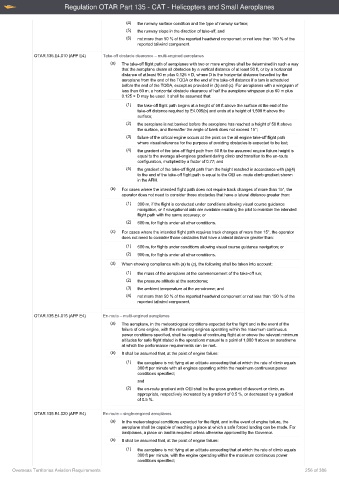Page 256 - Overseas Territories Aviation Requirements Consolidated - Total AOC
P. 256
Regulation OTAR Part 135 - CAT - Helicopters and Small Aeroplanes
(4) the runway surface condition and the type of runway surface;
(5) the runway slope in the direction of take-off; and
(6) not more than 50 % of the reported headwind component or not less than 150 % of the
reported tailwind component.
OTAR.135.E4.010 (APP E4) Take-off obstacle clearance – multi-engined aeroplanes
(a) The take-off flight path of aeroplanes with two or more engines shall be determined in such a way
that the aeroplane clears all obstacles by a vertical distance of at least 50 ft, or by a horizontal
distance of at least 90 m plus 0.125 × D, where D is the horizontal distance travelled by the
aeroplane from the end of the TODA or the end of the take-off distance if a turn is scheduled
before the end of the TODA, except as provided in (b) and (c). For aeroplanes with a wingspan of
less than 60 m, a horizontal obstacle clearance of half the aeroplane wingspan plus 60 m plus
0.125 × D may be used. It shall be assumed that:
(1) the take-off flight path begins at a height of 50 ft above the surface at the end of the
take-off distance required by E4.005(b) and ends at a height of 1,500 ft above the
surface;
(2) the aeroplane is not banked before the aeroplane has reached a height of 50 ft above
the surface, and thereafter the angle of bank does not exceed 15°;
(3) failure of the critical engine occurs at the point on the all engine take-off flight path
where visual reference for the purpose of avoiding obstacles is expected to be lost;
(4) the gradient of the take-off flight path from 50 ft to the assumed engine failure height is
equal to the average all-engines gradient during climb and transition to the en-route
configuration, multiplied by a factor of 0.77; and
(5) the gradient of the take-off flight path from the height reached in accordance with (a)(4)
to the end of the take-off flight path is equal to the OEI en- route climb gradient shown
in the AFM.
(b) For cases where the intended flight path does not require track changes of more than 15°, the
operator does not need to consider those obstacles that have a lateral distance greater than:
(1) 300 m, if the flight is conducted under conditions allowing visual course guidance
navigation, or if navigational aids are available enabling the pilot to maintain the intended
flight path with the same accuracy; or
(2) 600 m, for flights under all other conditions.
(c) For cases where the intended flight path requires track changes of more than 15°, the operator
does not need to consider those obstacles that have a lateral distance greater than:
(1) 600 m, for flights under conditions allowing visual course guidance navigation; or
(2) 900 m, for flights under all other conditions.
(d) When showing compliance with (a) to (c), the following shall be taken into account:
(1) the mass of the aeroplane at the commencement of the take-off run;
(2) the pressure altitude at the aerodrome;
(3) the ambient temperature at the aerodrome; and
(4) not more than 50 % of the reported headwind component or not less than 150 % of the
reported tailwind component.
OTAR.135.E4.015 (APP E4) En-route – multi-engined aeroplanes
(a) The aeroplane, in the meteorological conditions expected for the flight and in the event of the
failure of one engine, with the remaining engines operating within the maximum continuous
power conditions specified, shall be capable of continuing flight at or above the relevant minimum
altitudes for safe flight stated in the operations manual to a point of 1,000 ft above an aerodrome
at which the performance requirements can be met.
(b) It shall be assumed that, at the point of engine failure:
(1) the aeroplane is not flying at an altitude exceeding that at which the rate of climb equals
300 ft per minute with all engines operating within the maximum continuous power
conditions specified;
and
(2) the en-route gradient with OEI shall be the gross gradient of descent or climb, as
appropriate, respectively increased by a gradient of 0.5 %, or decreased by a gradient
of 0.5 %.
OTAR.135.E4.020 (APP E4) En-route – single-engined aeroplanes
(a) In the meteorological conditions expected for the flight, and in the event of engine failure, the
aeroplane shall be capable of reaching a place at which a safe forced landing can be made. For
landplanes, a place on land is required unless otherwise approved by the Governor.
(b) It shall be assumed that, at the point of engine failure:
(1) the aeroplane is not flying at an altitude exceeding that at which the rate of climb equals
300 ft per minute, with the engine operating within the maximum continuous power
conditions specified;
Overseas Territories Aviation Requirements 256 of 386

